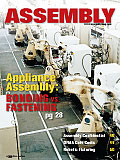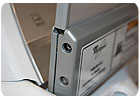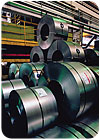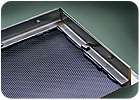
Aluminum, copper, steel and other metal parts used to assemble household appliances are usually joined together with mechanical fasteners or welding. But, structural adhesive is a serious alternative that more and more engineers are considering.
Structural adhesives are typically associated with automotive and aerospace applications. They’re also widely used in the boat-building industry. Potential advantages of using acrylics, epoxies, urethanes and other adhesives include cost savings, design flexibility, lower weight and structural integrity.
Many appliance manufacturers are examining the pros and cons of bonding, because it offers numerous benefits, such as design aesthetics, vibration dampening, and the ability to join dissimilar substrates and sensitive materials with a continuous joint. A wide variety of appliances are already assembled with adhesive, especially products that contain large amounts of injection-molded plastic parts, such as coffeemakers, humidifiers and vacuum cleaners.
“The concepts applied to the automotive and aerospace industries are being applied to the appliance industry,” says Kyle Rhodes, plastics market segment manager at Dymax Corp. (Torrington, CT). “The ability to create lighter and more robust designs with a more aesthetically pleasing contour targets the consumer market, and consumers are responding positively.
“Traditionally, appliance manufacturers used mechanical fasteners due to concerns over strength, durability and initial cost,” explains Rhodes. “But, as seen from the automotive and aerospace industries, the strength, durability and cost issues are minimal once the right adhesive is selected. Strength and durability have improved as new generations of adhesives are introduced. The cost savings far outweigh the actual costs, due to increased throughput with minimal labor costs.” Rhodes estimates that 50 percent to 60 percent of all available joints in appliances could be converted to adhesive.
“Today’s structural adhesives are formulated to withstand severe impact and peel forces, provide high sheer strength, and offer excellent chemical and temperature resistance,” adds John Lafond, market development manager for appliance and electric motors at Henkel Technologies (Rocky Hill, CT). “As a result of these advancements, appliance manufacturers are using structural adhesives to replace or augment rivets, bolts, welding and other traditional methods.”

Screws are used to attach the horizontal door of this washing machine.
Numerous Applications
Structural adhesive is now a viable option when assembling large appliances. It is used to attach reinforcement ribs in the corner of large sheet metal assemblies, such as dishwashers; bond refrigerator shelf assemblies; attach dryer drum assemblies; and bond retaining gears to shafts for washing machines.Appliance manufacturers use acrylics to bond stainless steel brackets used in electric and gas ranges. Methacrylates are used to bond plastic inner liners to metal frames and metal doors and frame joints in refrigerators and freezers. Acrylics are used to bond compressors to pans.
When assembling clothes washers, manufacturers use methacrylates to bond and seal console panels and drum casing covers. Acrylics and epoxies are used to bond door windows to door frames of front-load washers and dryers.
Other common applications include electronic components, control panels and motors. For example, magnets are often bonded to electric appliance motors. Epoxies, both one- and two-part types, have traditionally been used for motor assembly. But, newer technologies, such as acrylic-based products, are used at an increasing rate because they set and cure rapidly without heat.
“Older appliance motor technology involved the use of clips and other mechanical means to fixture magnets,” says Robert Wallach, technical manager at National Adhesives (Bridgewater, NJ). “High-strength adhesives have all but replaced that method of assembly. Efforts to increase productivity have also led to the use of fast-curing acrylic adhesives for magnet assembly within the electric motor.”
Wallach claims there is an increasing amount of bonding and sealing done on household appliances today. Of course, many adhesives are used for nonstructural applications. For instance, as the electronic components of appliances become more complex, many devices are encapsulated with epoxies and sealants to protect their circuitry against heat and moisture. But, engineers are also finding more uses for structural adhesives.
“The replacement of spot welding with adhesives is gaining more acceptance than five year ago,” explains Harry Arnon, president of Hernon Manufacturing Inc. (Sanford, FL). “More joints are being designed for structural adhesive bonding instead of spot welding. This design modification will increase the usage of structural adhesives within the appliance industry.”
Although many new adhesives can be stronger than traditional joining methods, screws, bolts and rivets still remain popular with appliance engineers. “Fasteners often allow for disassembly and removal of components,” notes Brian Bentrim, P.E., manager of global new product development at PennEngineering (Danboro, PA). “This is especially important in serviceable applications. But, it can be critical for product development, as well, when it may be important to open, change or check an application. Fasteners are also often stronger than an adhesive.”

Faced with rising prices, many appliance manufacturers have been forced to use thinner sheet metal.
Design Trends
Weight reduction is a major trend in the appliance industry today, with many manufacturers using more plastic materials and thinner metals. Aesthetics is also a huge concern, especially at the high end of the market, which offers higher profit margins, but more discerning consumers. For instance, a high-end dishwasher would likely use large amounts of stainless steel, while a lower-end model would probably use more acrylonitrile butadiene styrene (ABS) or nylon components.Designs and features are becoming more sophisticated today. At the recent Kitchen and Bath Industry trade show in Chicago, manufacturers displayed a wide variety of appliances in bold colors. According to home design experts, consumers are using their kitchens for a lot more than just cooking today. They’re knocking down the once highly defined walls between cooking and dining areas. As a result, they want appliances that are versatile and ease to use, yet stylish and unobtrusive.
“As appliances become more integrated into the living spaces of homes, there is definitely more thought being put into their appearance,” notes Todd DiMartini, business manager for industrial adhesives and tapes at 3M Co. (St, Paul, MN). And, with the increased use of electronics, he says there is more need for adhesives to stabilize components, stake wires and pot assemblies in environments that can be rugged. “Structural adhesives provide invisible fastening with minimal surface distortion on a variety of substrates,” DiMartini points out.
With adhesive bonding, unsightly rivets, protruding bolts, screw heads and surface markings, such as spot welds, are eliminated, resulting in a smooth surface. Time-consuming operations required to remove welding slag and prepare the surface for finishing can also be avoided with adhesives.
“The use of structural adhesives in the appliance industry has increased, primarily driven by innovation in product designs and rising raw material costs,” explains Lafond. He says there has been a proliferation of new appliances with a sleeker, cleaner appearance “where mechanical fasteners and welding can create problems maintaining product aesthetics.” Other design trends that are driving use of adhesives include smooth-top stoves and front-loading washers and dryers.
Plastics use in the appliance industry is not a new trend, but the material continues to evolve in terms of better strength, better luster, color options and heat resistance. Because it is lightweight, versatile and flexible, plastic allows new technological innovation and design freedom. It enables more design flexibility and often delivers lower overall costs than metal and other alternatives.
“The basic square designs with mechanical fasteners [of the past] are being replaced with molded plastic panels,” says Rhodes. “Vibration and noise is being reduced by using a structural adhesive over a mechanical fastener.”
Many appliance manufacturers are using greater amounts of plastics in their products, such as clear or translucent components in vacuum housings. As they become more intricate in their designs, a clear plastics structural adhesive may be a good alternative to screws. For instance, it gives designers new options for their concepts.
The increasing use of plastics often precludes the use of mechanical fasteners, which can damage the material. As plastics use proliferates in the appliance industry, “adhesive offers a competitive advantage over more traditional joining techniques,” says Doug Ellerbusch, adhesives marketing manager at Huntsman Advanced Materials (The Woodlands, TX). “This is especially true for polyurethane and methacrylate adhesives, which are tailor-made for bonding thermoplastics.”
However, it’s difficult for plastic to compete with sheet metal on cost, strength and appearance in large parts, such as cabinets, tops and bases. As a result, big appliances, such as dishwashers, dryers, refrigerators, stoves and washing machines, still use large amounts of metal.
The frames on those items are traditionally welded together. But, Wallach says alternate technologies have been investigated, such as bonding the frame housing. “[The industry is still tackling] the need for high-strength adhesives to set as quickly as traditional methods, such as welding,” he explains. “But, interesting developments with epoxies, particularly rapid curing via induction heating, are being explored as alternatives.”
Due to widespread consumer demand, the appliance industry continues to favor stainless steel. “There has been a shift to alternative stainless steel grades to mitigate raw material cost increases,” says Lafond. “These grades are not easily weldable and adhesives eliminate this difficulty.”
Appliance manufacturers are also using more prepainted steel to achieve a lower environmental imprint. “As the use of coil-coated steel increases, the use of adhesives may increase, since the substrates can’t be welded without damaging the paint,” explains David Speth, senior engineer at the Edison Welding Institute (EWI, Columbus, OH).
With the price of steel continuing to soar, appliance manufacturers have been economizing by using thinner sheet metal. However, traditional joining techniques don’t always work well with thinner materials. “As steel gets thinner, sheets can become more difficult to weld,” explains Speth. “As you go thinner, material strength goes down.”
The fasteners and tools that were effective on older, thicker parts aren’t as compatible with thinner materials either. For example, when fastening sheet metal less than 0.025 inch thick, thread stripping becomes a serious issue. The seating torque is too close to the thread-forming torque and the prevailing torque.
By using adhesives instead of fasteners or welding, appliance engineers can spread the stress out over a wider area, says Dave Archer, president of Archetype Joint LLC (Orion, MI). “Appliances are a logical application for adhesives,” he points out. “It allows you to hide lines and join large areas of flimsy material.”

Two-part silicone adhesive is used to bond and seal this glass stove top to its stainless steel frame. It is also used to bond steel support brackets directly to the underside.
Fasteners Still Rule
Archer says many engineers get nervous about strength. “When using adhesives, there is a fear of inconsistent results,” he explains. “In many cases, because there is such a wide variety of structural adhesive available, you need to think about it more than fasteners. Often, there must be an existing design problem that you want to overcome to justify adhesives.”In addition, Speth warns that stainless steel can cause problems for some adhesives, because of its ultrasmooth surface. “There aren’t many adhesives designed specifically for stainless steel,” he points out. “To get the best results, you may have to prime the surface, which can add time to the process. Epoxies would be my first choice, followed by urethanes. Acrylics are usually better for plastics.”
Adhesives also add to the number of chemicals used within a plant, which can raise environmental concerns. And, they usually require fixturing and time to cure, which can limit their use on high-volume assembly lines. “Cure time depends on chemistry,” says Speth. “Epoxies can cure in minutes to hours, while urethanes set in seconds to hours. With UV-cured acrylics, it’s just a matter of seconds or minutes.”
To overcome this challenge, most structural adhesive vendors offer a wide variety of cure time options. Appliance manufacturers can improve throughput by using fast-curing products, such as two-component structural adhesives or light-curable adhesives. However, many high-performance products, such as single-part epoxies, require a heat exposure cycle to cure. This extra step may or may not be part of an existing production process.
Those limitations can make fasteners and mechanical joining processes more appealing for some appliance applications. “Self-clinching fasteners provide solutions,” claims PennEngineering’s Bentrim. “They make it easier to work with thinner sheets, and provide convenience for assembly and disassembly.”
The latter is extremely important when it comes to recycling initiatives. European appliance manufacturers, for instance, must adhere to strict environmental regulations, which include “end-of-life” recycling programs. Adhesives create a relatively permanent bond that can be difficult to disassemble if repairs or alterations are needed.
Serviceability is a key factor that determines whether to use adhesive, fasteners or welding. Threaded fasteners are generally the only option that permits service access or replacement of inner parts and assemblies.
“If you have to take something apart, it’s a whole lot easier to do if that part is screwed or bolted, rather than welded or fastened,” says Speth. “Bonding is more permanent. Bonding sheet metal to a frame is one thing, but you probably wouldn’t want to bond the closer panel that covers the compressor.”
“Appliance manufacturers want to achieve in-place cost savings by using fasteners that form threads in stamped, punched or drilled holes,” adds Larry Pickett, director of marketing at Acument Global Technologies Inc. (Troy, MI). “By doing this, they achieve more in-place cost savings from thread-forming designs that overcome the inherent problems of fastening in thin sheet metal applications.”
According to Pickett, the appliance industry is also using more aluminum and, in some cases, powder metal stampings vs. steel stampings. He says fasteners still remain popular for steel applications such as hinges, electrical assemblies and main wall assembly.
“The biggest advantage to using fasteners is that newly assembled appliances can undergo rough treatment during shipment to final destinations,” claims Pickett. “This can cause parts to move slightly-particularly washer and dryer spin mechanisms-leading to expensive servicing requirements upon arrival.”
Manufacturing engineers must carefully consider the advantages and disadvantages of adhesives, fasteners and welding. “The most important limitation of both thermal joining and mechanical fastening is cost,” argues Henkel’s Lafond. “Thermal joining is an expensive process that requires specialized labor. Welded joints are often nonuniform, lack the clean aesthetics desired for high-end applications and are very difficult to disassemble.”
In addition to eliminating the cost for fasteners and fastening equipment, structural adhesives can eliminate the cost of drilling and tapping holes, as well as sealing devices such as gaskets. “Mechanical fastening requires costly labor to drill holes and insert fasteners, a process that cannot be easily automated,” Lafond points out.
“Holes for fasteners can create leak paths, a starting point for corrosion, and may detract from the visual aesthetics of the end product,” adds Lafond. “Because fasteners and thermal joining both concentrate stress at a single point, they have difficulty withstanding stresses caused by flex or vibration, which can result in premature joint failure.” A
Sidebar: Joint Design Is Important
When switching from mechanical fasteners to adhesive bonding, joint designs must be carefully reviewed and altered if necessary. As a result, most experts recommend applying structural adhesive only when engineers are creating new products.Adhesives depend on surface contact to create a bond to the substrate. Therefore, joints must be designed to give the adhesive as much surface contact as possible. Lap joints are the most commonly used adhesive joint and work best with metal applications. “Mechanically, you want to design the joint to load the bond in shear, not in peel,” warns David Speth, senior engineer at the Edison Welding Institute (EWI, Columbus, OH).
While structural adhesives work with many different materials, the best product to use for a given application is generally a function of part design, processing needs and performance requirements. “Different substrates require different adhesives,” explains Speth. “Adhesives are particularly valuable if joining dissimilar materials, such as steel to other metals, metals to plastics, plastics to each other, or painted metals to anything else.
“In general, you want the adhesive to be slightly less stiff than the substrates,” adds Speth. “Polyolefins and fluoropolymers are very difficult to bond. Only a few highly specialized adhesives work. Open cell foams have a low surface area for bonding.”

